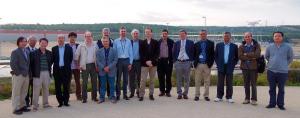Integrated modelling experts get hands-on experience
For three days last month, representatives from all seven ITER Members came together at ITER Headquarters for the 5th meeting of the Integrated Modelling Expert Group (IMEG). The group meets regularly to help guide the ITER integrated modelling (IM) program and to act as an interface between Member physics modelling programs and the ITER Organization.
The aims of the ITER IM program are to meet the needs of the ITER Project for accurate predictions of ITER performance and for efficient control of ITER plasmas; to support the preparation for ITER operation; and, in the longer term, to provide the modelling and control tools required for the exploitation phase of ITER.
At the meeting chaired by Lang Lao (US), each of the Members had the opportunity to update the assembly on their respective programs before hearing about progress within the ITER Organization. Since the 2012 meeting, the ITER Organization has now established an integrated modelling prototype framework. Called the Integrated Modelling & Analysis Suite (IMAS), this framework comprises various elements including the ITER Physics Data Model that is designed to be used for both experimental and simulation data—a significant step compared to existing machines. The rules and guidelines that underpin the data model have undergone extensive review and will now be used to derive specific elements (Interface Data Structures) of the data model that are used to pass data between physics codes running in an integrated modelling workflow.
On the final day of the meeting, an introductory training session was prepared which gave the IMEG members the opportunity to gain some hands-on experience with the IMAS prototype. The expert group commended the ITER Organization for the progress made on the IMAS Framework, on the first physics workflows demonstrating a plasma simulator (based on modular prescribed and free-boundary transport simulations) and on the associated program documentation. They were also keen to encourage wider access to the IMAS Framework and further training opportunities as the framework is further developed.
More information on the ITER IM Program, how to get involved, or how to contribute to its development can be obtained by contacting @email.


